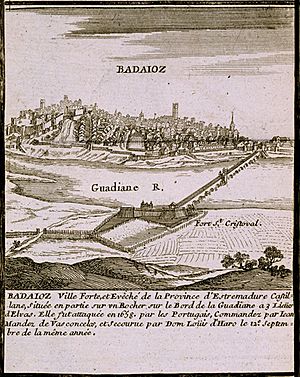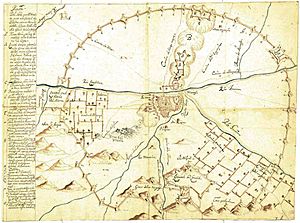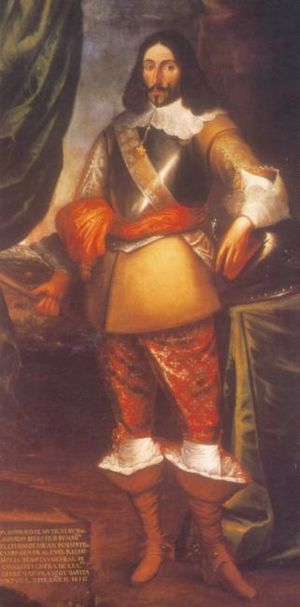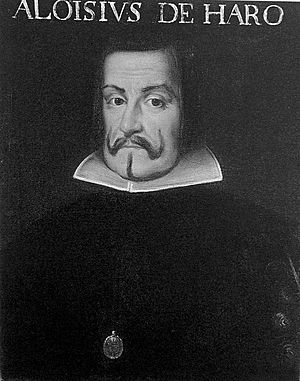Siege of Badajoz (1658) facts for kids
Quick facts for kids Siege of Badajoz |
|||||||
|---|---|---|---|---|---|---|---|
| Part of the Portuguese Restoration War | |||||||
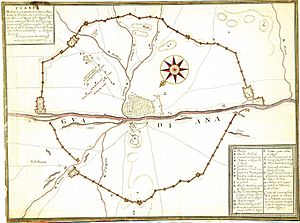 Map of the Siege of Badajoz by João Nunes Tinoco |
|||||||
|
|||||||
| Belligerents | |||||||
| Commanders and leaders | |||||||
| Joanne Mendes de Vasconcelos | Francisco de Tuttavilla Rodrigo de Múgica Luis de Haro |
||||||
| Strength | |||||||
| 14,000 infantry, 3,000 cavalry, 20 cannons, 2 mortars |
4,000 infantry, 2,000 cavalry (garrison) 12,000 infantry, 4,000 cavalry (relief army) |
||||||
| Casualties and losses | |||||||
| 6,200: dead (by the plague and combat) or deserters | Unknown | ||||||
The Siege of Badajoz in 1658 was a big battle during the Portuguese Restoration War. A large Portuguese army tried to capture the Spanish city of Badajoz. This city was very important for the Spanish army in the region of Extremadura.
Badajoz had old medieval walls that the Portuguese thought were weak. They had tried to attack the city three times before. In 1658, the Portuguese army, led by Joanne Mendes de Vasconcelos, marched from Elvas to Badajoz.
The city was not well-defended at first. The Spanish troops, led by Francisco de Tuttavilla, mostly tried to survive until help arrived. The Portuguese first tried to capture a key fort called San Cristóbal. But after 22 days of fighting, they gave up on that plan.
Instead, the Portuguese started building a wall around Badajoz. This wall, called a circumvallation, was meant to cut off the city. They captured a Spanish fort called San Miguel, which helped their plan. However, the siege lasted four months. During this time, many Portuguese soldiers died, mostly from a disease called the plague. Others simply left the army.
Finally, a Spanish army arrived in October to help Badajoz. This army was led by Luis de Haro. The Portuguese commander, Mendes de Vasconcelos, had to give up the siege. He was later removed from his position and put in prison for failing.
After this, the Spanish army invaded Portugal and tried to capture Elvas. But the Portuguese managed to defeat the Spanish in a big battle called the Battle of the Lines of Elvas. This victory helped Portugal keep its independence.
Contents
Why the Siege Happened
After the death of the Portuguese King John IV in 1656, Spain launched attacks into Portugal. These attacks came mainly from a region called Extremadura. Another attack front was opened from Galicia to make Portugal split its forces.
The Spanish army in Extremadura was strong. It had many experienced soldiers who had fought against France. This army was led by Francisco de Tuttavilla. In 1657, the Spanish captured the Portuguese town of Olivença. They also took another town called Mourão.
The Portuguese commander, Count of San Lorenzo, was replaced. The new commander was Joanne Mendes de Vasconcelos. He quickly managed to take back both Mourão and Olivença. This was because many Spanish soldiers had been moved to fight in other places.
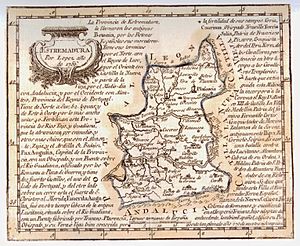
Mendes de Vasconcelos felt confident after these wins. He promised the Portuguese Queen that he would capture Badajoz. Badajoz was the most important Spanish fortress near the Portuguese border. Another idea was to attack the city of Tui in Galicia. Some thought this would be easier and more helpful. But the Queen and her advisors preferred Mendes de Vasconcelos' plan.
He was given a large army. It had 14,000 foot soldiers and 3,000 horsemen. They also had 20 cannons and 2 mortars. This army gathered at the main fortress of Elvas.
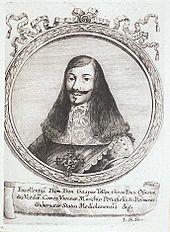
At that time, the Spanish city of Badajoz had about 4,000 foot soldiers and 2,000 horsemen. The main commander was the Duke of San German. The city's defenses were old. They included an ancient Moorish castle called an Alcazaba. There was also a medieval wall from long ago. But since the war started in 1640, new defensive structures had been added. These included strong points called bulwarks and ravelins.
The Siege Begins
First Attacks and Plans
The Portuguese army left Elvas on July 12th. They arrived outside Badajoz the next day. A group of Portuguese horsemen met some Spanish horsemen near the Guadiana river. Both sides fought hard and lost many men. The Spanish then went back behind the city walls.
Mendes de Vasconcelos arrived with the main Portuguese army. He had all his cannons and many supply wagons. Seeing how strong the Portuguese army was, the Duke of San German quickly sent a message to King Philip IV asking for help.
Even though a Portuguese attack was expected, the Spanish in Badajoz were in a bad situation. The Duke of San German made soldiers and civilians work on the defenses. They also stored food. The Portuguese soldiers, called sappers, started preparing for an attack.
Mendes de Vasconcelos decided to attack Fort San Cristóbal. This fort was very important for Badajoz's defenses. It was built after 1640 and protected a bridge over the Guadiana river. This bridge was the way into the city. The Spanish quickly made a small fort stronger on the bridge. They also dug wider trenches to connect it to Fort San Cristóbal.
The Portuguese planned their attack carefully. But the attack was a big failure. After 22 days of fighting, the Spanish defenders fought back strongly. They used musket fire and firebombs. Mendes de Vasconcelos ordered his troops to pull back.
Trying to Surround the City
The Portuguese general realized he couldn't take Badajoz by direct attack. So, he changed his plan. He began to build a wall around the city. This was to completely cut off Badajoz from outside help. This type of wall is called a circumvallation.
Meanwhile, the Spanish kept making their own defenses stronger. They built more ravelins between their old medieval towers. They also strengthened small forts outside the city. This was to make it harder for the Portuguese to build their wall. One of these forts was San Miguel. It was a star-shaped fort that could hold 600 foot soldiers.
Portuguese sappers built a floating bridge over the Guadiana river. This bridge connected two Portuguese camps. It allowed Mendes de Vasconcelos' troops to cross the river easily. They built part of their circumvallation wall without trouble. A Spanish fort called Fort del Mayordomo was abandoned. The Portuguese used it to help build their wall.
The Portuguese wanted to capture the Convent of San Gabriel. All the Portuguese horsemen and five groups of soldiers were sent for this. They easily took over the convent. The Spanish soldiers there quickly gave up. Then, Portuguese sappers started building a fort near an old watchtower.
The Spanish Fort of San Miguel was stopping the Portuguese from finishing their wall. So, capturing it became a top goal. On June 20th, after some cannon fire, the Portuguese attacked. The Spanish cavalry and foot soldiers came out of Badajoz to fight them. But the Portuguese fought back. Fort San Miguel finally surrendered.
Small Fights and Bombardment
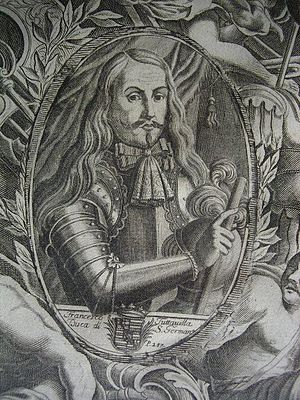
Capturing Fort San Miguel allowed the Portuguese to finish their circumvallation wall. This wall was a line of small forts. Each fort could hold about 200 soldiers. The Spanish also kept making their defenses stronger.
Not many big battles happened during this time. There was an ambush by the Portuguese against a Spanish supply convoy. The Spanish also made small attacks from Badajoz to stop the Portuguese work. In one night attack, the Spanish caused the Portuguese to lose 200 foot soldiers and 40 horses.
On August 6th, the Spanish commanders, Osuna and San German, left the city. With 1,200 horsemen, they broke through the Portuguese lines. San German was replaced as commander of Badajoz by Rodrigo de Múgica y Butrón. The Spanish focused on defending a large ravelin with 2,000 foot soldiers and 1,000 horsemen.
By late August, news reached the Portuguese camp that a Spanish relief army was coming. This army was led by Luis de Haro. This made Mendes de Vasconcelos feel more pressure to finish the siege. But the Portuguese cannons hadn't done much damage. Also, heat and disease were causing many Portuguese soldiers to die.
Help Arrives
Luis de Haro, a favorite of King Philip IV of Spain, decided to lead the relief army himself. He didn't have military experience. His army had about 12,000 foot soldiers and 4,500 horsemen.
Haro didn't reach Badajoz until mid-October. But when he arrived, Mendes de Vasconcelos had to give up the siege. The Portuguese burned their buildings and destroyed a bridge. The Portuguese army then retreated back to Elvas. They had lost 6,200 men in total. These men either died in battle or from disease.
What Happened Next
When the Spanish relief army arrived, Luis de Haro entered Badajoz. People cheered him as a hero. In Portugal, Queen Luisa de Guzmán put Mendes de Vasconcelos in prison for failing to capture Badajoz.
News of more bad luck for Portugal came from the north. A Spanish army entered Portuguese land in September. They defeated a Portuguese army in a battle. The Spanish then captured several Portuguese strongholds.
Luis de Haro decided to attack Portugal himself. He marched towards the Portuguese fortress of Elvas. The Spanish army reached Elvas on October 22nd and started a siege. The defenses of Elvas were strong enough to hold out for a while. This gave the Portuguese time to gather a new army.
On January 17th, the Portuguese attacked the Spanish. The battle was tough at first. But after some time, the Portuguese managed to break through the Spanish lines. The Spanish had to retreat to Badajoz. They lost many men, cannons, and weapons.
The Portuguese army tried to besiege Badajoz again shortly after. But they failed to take the city once more. By then, a peace treaty had ended Spain's war with France. So, taking back Portugal became King Philip IV's main goal.
See also
 In Spanish: Asedio de Badajoz (1658) para niños
In Spanish: Asedio de Badajoz (1658) para niños


